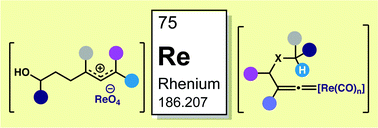Rhenium-catalysed reactions in chemical synthesis: selected case studies
Abstract
This Perspective presents and discusses a selection of examples that reinforce the enabling and distinctive reactivity provided by homogeneous rhenium catalysis in chemical synthesis. Specifically, the ability for lower oxidation state rhenium–carbonyl catalysts to engage alkyne, allene, and enol substrates in various carbon–carbon bond-forming reactions is highlighted. The inherent capacity of Lewis acidic, higher oxidation state oxorhenium catalysts to facilitate the transposition/isomerisation of allyl alcohols and attendant functionalisation via reaction cascades is also showcased. A brief overview of representative rhenium catalysts that have allowed for reductions of imines, carbonyls, and related compounds is also provided.

- This article is part of the themed collection: 2022 Frontier and Perspective articles


 Please wait while we load your content...
Please wait while we load your content...